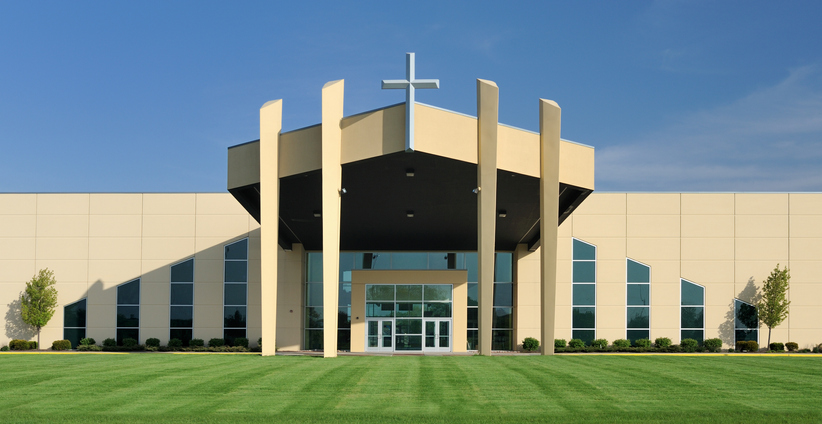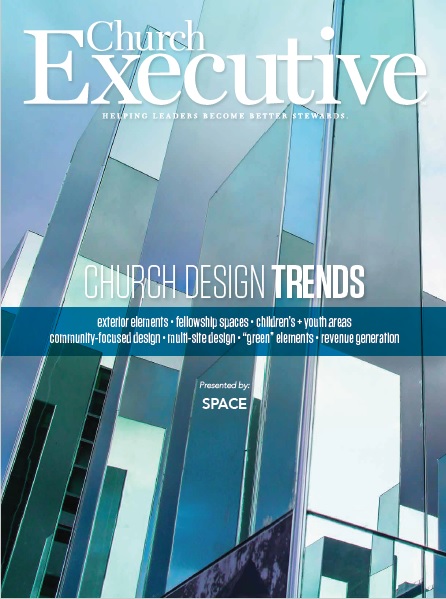
Exterior elements • Fellowship spaces • Children’s + Youth areas • Community-focused design • Multi-site design • “Green” elements • Revenue generation

Partner
SPACE
Let’s start from the outside in. What exterior / outdoor church design elements are popular?
Thomas Small, AIA/NCARB: Most churches we work with are contemporary by nature; therefore, they’re looking for clean/modern designs that appear more like a retail building than a traditional church.
Many churches went away from crosses on the outside of the building over the past decade. However, we’ve recently noticed that trend is starting to change. In the past few years, a number of our church clients have started requesting cross designs that express their faith while also enhancing the architecture of their building.
We’re working with several churches that are putting a lot of emphasis on exterior youth spaces with amenities such as basketball courts, fellowship spaces (fire pits and so on) sand volleyball courts, and more.
Moving inside — primarily, fellowship spaces — what design elements are most in-demand?
Mark Allen: The one programming element that’s common to almost every church we serve is a “welcoming front door” and a large multi-purpose lobby which allows for fellowship activities.
The main lobby is no longer used only for the purpose of filling and exiting the main auditorium, but is also used for extended fellowship time before, after and between services.

Partner
SPACE
Many of our lobbies also contain specialized furnishings and amenities, such as group “living-room spaces” with a fireplace, coffee / café shops, bookstores / libraries, and similar features.
Which children’s / youth space design elements resonate most?
Small: Within children’s departments, the trend of theming with cartoonish wallcoverings has been replaced with a much cleaner, subtle design approach. On the basic level, this can be as simple as using a thoughtful, deliberate color scheme and classroom designations based on an interpretive plan.
Where budgets allow, full theming uses 3-dimensional elements representing real-life features (trees, clouds, nature) that tie into the department’s vision and teaching methodology.
The entrance into the children’s department often receives special attention to create extra interest and excitement.
What other amenities are families looking for?
Allen: While parents are always looking for features that excite their children and entice them to attend, they are equally (if not more so) interested in safety and security.
Designing for community engagement seems to have become a focus. What does community-engaging design look like on a church campus?
Small: Exterior fellowship areas are becoming a norm in church design. As pastors lead followers to live out their faith seven days a week and live in community, they’ve started creating outdoor community spaces for that fellowship to happen. It has become normal to have large sun-screened outdoor gathering spaces for all times of the week, often including fireplaces or firepits as well as other amenities.
In some smaller communities where public use areas are limited, some churches have found the opportunity to provide those on their campus. One of our church clients in a town of about 13,000 actually hosts the Fourth of July celebration each year for the entire community.
Is multi-site church design still very popular?

Allen: In our opinion, multi-site design has become a huge part of the mainstream church and will likely not go away. Multi-site churches make sense in many ways:
• Under-resourced churches have the option of merging with a well-resourced church, easing the financial burden of operations.
• Centralized administration and leadership can lighten the directional / administration burden and reduce local staff sizes to focus specifically on community care.
• The deeper an organization’s leadership pool, the stronger the leadership which emerges.
• Creating multiple sites that are well-spaced-out can eliminate the need to travel long distances to receive the same worship / community experience.
• The trend of the relative sizes of multi-site churches seems to be contracting a bit (from 800 to 1,200 seats down to 600 to 1,000 seats), while the number of campuses continues to increase.
Do you find church leaders are looking for green, or energy-efficient, design elements in recent years?
Small: Sustainable, energy-efficient design is always of interest to churches, both as a responsibility and for potential energy savings once the building is placed into service. However, since many areas of the church building are used intermittently throughout the week, the opportunity to recapture additional construction costs for alternative energy sources, upgrades in insulation values, and so on are drastically reduced.
Spaces which are used throughout the week (i.e., office suites) are most often the best candidates for using alternative approaches which might cost more up front, as those costs can then be recovered much quicker.
If a church wants its campus to act as a financial opportunity (versus liability), is there a way to ‘build that in’?
Allen: From a financial perspective, a church can avoid being a liability to its members and staff if it can be self-sustaining and therefore escape the trap of building more than what it needs and can afford. Consulting with a knowledgeable, experienced church architect can be an excellent way to avoid this mistake. An expert can help the church master plan its future, and then phase development to correlate with their finances and growth plan.
Is it important that an architect or builder work with capital fundraisers, planned giving experts and accountants?
Small: Embarking on a new building or development project should always be done with thorough planning, consulting, and financial advice. Soliciting this from the start will help to avoid “mistakes” that can prove costly to correct later.
— Reporting by RaeAnn Slaybaugh


